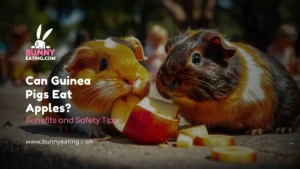Greetings to our extensive guide to rabbit chew stems. You’ve come to the perfect spot if you’re a rabbit owner trying to give your pet safe, interesting chewing options. We’ll go over all you need to know about chew branches in this series of articles, such as benefits, drawbacks, nutritional value, and safe use. We can help with any inquiries you may have on safe branch types for rabbits or how to keep an eye on your pet’s health. Collectively, we will discover the world of chew branches and find ways to keep your bunny happy and well. Can Rabbits Chew Branches?
Safe Alternative to Rabbit Eat Chew Branches
Feeding your bunny chew stems is an excellent way to promote oral health and sate their innate need to chew. Not every branch, though, is secure for rabbits. Choose chew twigs that have been specially picked and processed for rabbits rather than haphazard branches from unknown sources. Pet supply stores and internet merchants specialising in rabbit goods typically carry these. These branches go through procedures to ensure that they are safe for your rabbit to nibble on—they are devoid of harmful pesticides and chemicals.
Risks of Feeding Chew Branches
Rabbits can safely gnaw on branches, but there are still specific worries. If the leaves are not supplied correctly, there is a chance that they will become polluted by pesticides or other pollutants. Also, if branches break into sharp pieces or are not the right size, rabbits could hurt themselves. It’s crucial to watch over your bunnies while they chew and remove any tiny or pointy pieces to avoid consuming them and possibly triggering digestive issues.
Effects of Chew Branches on Rabbit
Chew branches provide both physical and mental stimulation for rabbits. Physically, chewing helps wear down their continuously growing teeth, preventing dental problems. Mentally, chewing branches mimics their natural behaviour in the wild, keeping them entertained and reducing boredom. Overall, incorporating chew branches into your rabbit’s environment can contribute to their overall well-being.

Are Chew Branches Good for Rabbit
Yes, chew branches are beneficial for rabbits. They fulfil their instinct to chew, which is essential for dental health. Regular chewing on branches helps prevent dental problems such as overgrown teeth and keeps your rabbit mentally stimulated. Additionally, chew branches provide enrichment, offering rabbits a safe and appropriate outlet for their chewing behaviour.
Nutritional Value of Chew Branches for Rabbit
While chew branches don’t provide significant nutritional value in terms of vitamins and minerals, they offer essential dental benefits for rabbits. The act of chewing wears down their teeth, which continuously grow throughout their lives. Additionally, chewing branches can aid in digestion by promoting the grinding action necessary for breaking down fibrous plant material in their diet.
How Chew Branches Are Made
Chew branches for rabbits are typically made from safe, non-toxic wood sourced from specific types of trees, such as apple, willow, or aspen. These branches are harvested, cleaned, and processed to remove any harmful substances like pesticides or herbicides. They are then cut into appropriate sizes and packaged for sale. Some companies may also treat the branches with natural flavourings to entice rabbits to chew on them.
What Types of Chew Branches Are Safe for Rabbits
Safe chew branches for rabbits include those made from hardwood trees such as apple, willow, aspen, or pear. These woods are non-toxic and safe for rabbits to chew on. Avoid branches from trees treated with pesticides or herbicides, as these can be harmful to your rabbit’s health. Additionally, steer clear of branches from toxic trees like cedar or pine.

Do Wild Rabbits Eat Chew Branches
Indeed, nibbling on branches is a natural activity for wild rabbits. Rabbits eat a wide range of plants in their native habitat, such as bark, twigs, and branches. They wear down their teeth, which are continually changing by chewing on trees. Branches are also used by wild rabbits as food when their supply is limited and as lumber for their nests.
Why Chew Branches Are Harmful to Rabbit
Chew branches can be harmful to rabbits if they are sourced from toxic trees or treated with chemicals. Toxic woods like cedar or pine can cause respiratory issues and other health problems in rabbits. Additionally, branches contaminated with pesticides or herbicides can be toxic if ingested. Sharp splinters or small pieces of wood can also pose a choking hazard or cause injuries to the rabbit’s mouth or digestive tract.
Store-bought Chew Branches and Rabbit
Store-bought chew branches specifically made for rabbits are generally safe and suitable for rabbits to chew on. These branches undergo processes to ensure they are free from harmful substances and are appropriately sized for rabbits to chew on safely. When purchasing chew branches, look for products labelled as safe for rabbits and avoid branches from unknown sources or those treated with chemicals.
How Often Can My Rabbit Eat Chew Branches
Rabbits can safely chew on branches every day as part of their enrichment and dental care routine. However, it’s essential to monitor their chewing behaviour and ensure they do not consume large quantities of wood, which could lead to digestive issues or blockages. Offer chew branches in moderation, alongside a balanced diet of hay, fresh vegetables, and pellets.
How Many Chew Branches are there
There is a wide variety of chew branches available for rabbits, ranging from different types of wood to various shapes and sizes. Common options include apple, willow, aspen, and pear branches. Additionally, some companies offer flavoured branches to entice rabbits to chew. The number of chew branches available may vary depending on availability and the preferences of both the rabbit and the owner.

How Do I Prepare Chew Branches
Preparing chew branches for your rabbit is relatively simple. If you’re harvesting branches from your garden, ensure they come from non-toxic trees and are free from pesticides or herbicides. Wash the branches thoroughly and allow them to dry before offering them to your rabbit. If purchasing store-bought chew branches, follow the instructions on the packaging, which may include rinsing or soaking the branches before use.
How nutritious are Chew Branches
Chew branches primarily offer dental benefits rather than nutritional value. While they contain some fibre, rabbits should primarily obtain their nutrition from hay, fresh vegetables, and pellets. However, chewing on branches helps wear down their continuously growing teeth, preventing dental problems and promoting overall oral health.
Preparing Chew Branches for Rabbits
ensure that the chew twigs are safe for your rabbit to gnaw on by carefully cleaning them before giving them to them. Select non-toxic trees when taking branches from your garden, and be sure to carefully wash each one to get rid of any dirt, insects, or residual chemicals. Before offering the limbs to your rabbit, let them dry. If you buy chew branches from a store, make sure to prepare them according to the maker’s proposals, which can include soaking or washing the branches before using them.
What should I combine Chew Branches with for my Rabbits?
Chew branches can be combined with other enrichment activities to keep your rabbit mentally and physically stimulated. Consider rotating chew branches with other toys, tunnels, and puzzle feeders to prevent boredom. Additionally, providing a variety of textures and materials for chewing, such as cardboard tubes or untreated wicker baskets, can further enrich your rabbit’s environment.
What If My Rabbit Eats a Large Amount of Chew Branches
If your rabbit consumes a large number of chew branches, monitor them closely for signs of gastrointestinal distress, such as decreased appetite, bloating, or unusual faecal output. Contact your veterinarian immediately if you notice any concerning symptoms. To prevent overconsumption, offer chew branches in moderation and supervise your rabbits while they chew.

How Much Chew Branches Can My Rabbit Eat
While chew branches are safe for rabbits to consume, it’s essential to offer them in moderation. Too much wood consumption can lead to digestive issues or blockages. Provide chew branches as part of a balanced enrichment routine, alongside a diet consisting primarily of hay, fresh vegetables, and pellets. Monitor your rabbit’s chewing behaviour and adjust the number of chew branches accordingly.
When shouldn’t you feed Chew Branches to your Rabbit?
Avoid feeding chew branches to your rabbit if they come from toxic trees such as cedar or pine or if they have been treated with pesticides or herbicides. Additionally, if your rabbit has a history of digestive issues or blockages, consult with your veterinarian before offering chew branches. Always supervise your rabbit while they chew to prevent ingestion of sharp splinters or large pieces of wood.
What if my Rabbit accidentally eats a lot of Chew Branches
If your rabbit accidentally consumes a large number of chew branches, monitor them closely for signs of gastrointestinal distress such as bloating, discomfort, or changes in faecal output. Contact your veterinarian immediately if you notice any concerning symptoms. To prevent overconsumption, offer chew branches in moderation and supervise your rabbits while they chew.
Monitoring Your Rabbit’s Health
Regularly monitor your rabbit’s health, including their appetite, behaviour, and faecal output, to ensure they are thriving. Pay attention to any changes in their chewing behaviour or signs of dental problems such as drooling or reluctance to eat. Schedule regular veterinary check-ups to address any health concerns promptly.
What actions should I take if my Rabbit consumes Chew Branches
If your rabbit consumes chew branches, monitor them closely for any signs of discomfort or digestive issues. Ensure they have access to plenty of fresh water and monitor their appetite and faecal output. If you notice any concerning symptoms such as bloating, lethargy, or changes in behaviour, contact your veterinarian immediately for guidance.

What Else Can I Feed My Rabbit
In addition to chewing branches, rabbits require a balanced diet consisting primarily of hay, fresh vegetables, and pellets. Hay should make up the majority of their diet and be available at all times. Offer a variety of leafy greens and vegetables daily, and limit fruit and high-starch vegetables as occasional treats. Pellets should be fed in moderation and chosen based on your rabbit’s age, size, and activity level.
How to Create a Rabbit-Friendly Garden
Creating a rabbit-friendly garden involves selecting safe plants and providing suitable enrichment for your rabbit to explore and nibble on. Choose non-toxic plants such as herbs, leafy greens, and flowers for your garden, and avoid toxic plants like lilies, daffodils, and foxglove. Incorporate rabbit-safe hiding spots, tunnels, and chew toys into your garden to provide enrichment and stimulation for your rabbit.
Rabbit Treats Made at Home
You can make homemade rabbit treats using simple, rabbit-safe ingredients. Some ideas include homemade hay cookies made from compressed hay and water, or fresh vegetable and herb treats such as carrot tops, parsley, or cilantro. Avoid using sugary or high-fat ingredients in homemade treats, and offer them sparingly as occasional rewards for your rabbit’s good behavior.

Conclusion
In the end, chew branches promote oral health in rabbits while offering them mental and physical activity. By being aware of the merits and drawbacks of chew branches, you may offer your bunny a secure and exciting habitat. To avoid future issues, make sure the branches your rabbit is chewing on are from non-toxic trees and keep an eye on its chewing habits. Introducing chew branches to your rabbit’s daily routine may improve their general happiness and well-being with the right care and attention. I hope your furry friend has many good hours of safe gnawing!
FAQs
-
Are chew branches safe for rabbits?
Yes, chew branches made from non-toxic wood are safe for rabbits to chew on. However, it’s essential to ensure they are sourced from safe trees and free from pesticides or chemicals.
-
How often can I give chew branches to my rabbit?
You can offer chew branches to your rabbit daily as part of their enrichment routine. Just be sure to monitor their chewing behaviour and remove any sharp or splintered pieces.
-
What types of chew branches are safe for rabbits?
Safe chew branches include those made from hardwood trees like apple, willow, aspen, or pear. Avoid branches from toxic trees such as cedar or pine.
-
Can wild rabbits eat chew branches?
Yes, wild rabbits naturally chew on branches as part of their diet and enrichment activities. Chew branches help wear down their teeth and provide mental stimulation.
-
What should I do if my rabbit eats a large amount of chew branches?
Monitor your rabbit closely for any signs of digestive issues or discomfort. Contact your veterinarian if you notice any concerning symptoms.
-
How should I prepare chew branches for my rabbit?
If harvesting branches from your garden, wash them thoroughly and ensure they come from non-toxic trees. If purchasing store-bought chew branches, follow the manufacturer’s instructions for preparation.
-
What other foods can I give my rabbit besides chew branches?
In addition to chewing branches, rabbits should primarily eat hay, fresh vegetables, and pellets to maintain a balanced diet. Offer treats like herbs or leafy greens in moderation.
-
How can I create a rabbit-friendly garden?
To create a rabbit-friendly garden, choose non-toxic plants and provide suitable hiding spots and enrichment for your rabbit to explore and nibble on.

Admin – Pet Expert shares valuable tips on pet care, nutrition, and health, offering practical advice to help your furry friends thrive.











